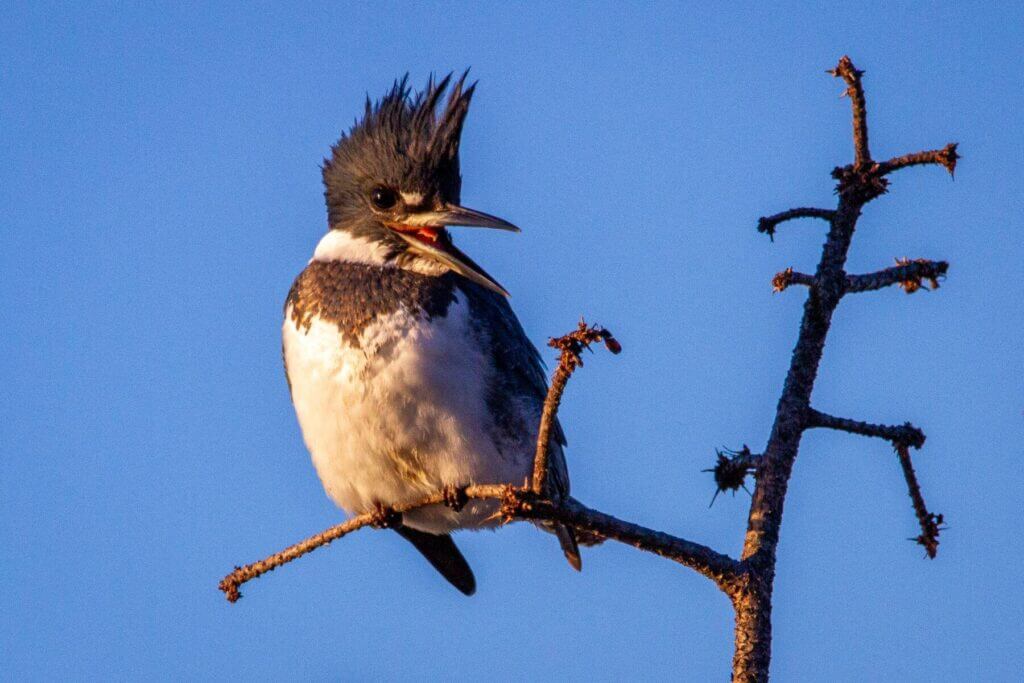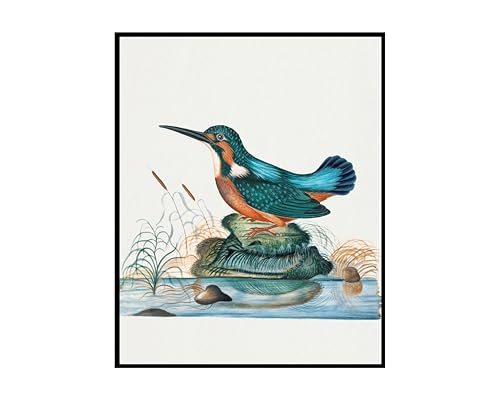Kingfishers are a diverse group of brightly colored birds found throughout the world. Known for their vibrant plumage and superb fishing skills, kingfishers have captured the human imagination for centuries. There are over 90 different species of kingfisher, each with its own unique traits and adaptations. In this article, we will spotlight the 10 most amazing types of kingfishers.
Introduction
Kingfishers are medium-sized birds in the family Alcedinidae. Their most distinctive feature is their large head, long, dagger-like bill, and short legs – a body design perfectly suited for diving into water to catch fish, their primary prey. Once they’ve captured a fish with their sharply pointed beak, they return to a perch to eat their meal.
Kingfishers come in a dazzling array of iridescent colors, from the vivid blue-and-orange plumage of the common kingfisher to the rusty red feathers of the oriental dwarf kingfisher. The male and female often have identical plumage, while juveniles tend to be a bit duller in color. These colors serve not just to attract a mate, but also to camouflage the bird as it waits perfectly still above the water for its next meal to swim near.
With over 90 unique species scattered across the globe, kingfishers have adapted to a wide variety of aquatic habitats, from slow meandering rivers to crashing ocean coastline. Some migrate long distances between breeding and wintering grounds, while others maintain more limited territories. But they all share that classic kingfisher talent for dramatic dives and fish hunting. Read on to learn more about 10 of the world’s most impressive kingfishers.
Blue-breasted Kingfisher
Native to central and western Africa, the blue-breasted kingfisher lives up to its name with deep blue upperparts and underparts, a russet collar, and a massive dagger-like black bill. Males and females have identical plumage. This kingfisher inhabits rivers, streams, swamps, and mangroves, perching quietly on branches overhanging the water. When it spots prey, it plunges headfirst into the water in a smooth, streamlined dive. Common prey includes fish, crustaceans, frogs, and aquatic insects.

Photo: Blue-breasted kingfisher. Credit: wikipedia
Common Kingfisher
With its bright blue back and wings, orange underparts, and iconic chattering call, the common kingfisher is one of the most recognizable kingfishers across Eurasia and North Africa. It frequents slow-moving rivers, streams, lakes, and coastlines. After finding a riverside perch, it scans the water intently for small fish before diving in headfirst to snatch its prey in its long red bill. Common kingfishers nest in burrows dug into riverbanks and lay bright white eggs.

Photo: Common kingfisher.
Belted Kingfisher
Found across North America, the belted kingfisher is a stocky bird with a shaggy crest, slate-blue upperparts, and a distinct white band across its breast and belly. Females have an extra chestnut band across the belly that males lack. Belted kingfishers inhabit rivers, lakes, estuaries, and coastlines, patiently watching for fish from low perches over the water. When it spots prey, it plunges headfirst into the water with its dagger-like bill open. Nests consist of tunnels dug into sandy riverbanks.

Photo: Belted kingfisher.
Amazon Kingfisher
As its name suggests, the Amazon kingfisher inhabits the waterways of the Amazon basin in South America. Its bright green-and-rufous plumage provides camouflage as it perches perfectly still above the water, waiting to dive for fish. With its massive dagger-like red bill and short tail, it plunges into the water headfirst to snare its prey. Though widespread, the destruction of its rainforest habitat has led to an overall population decline.

Photo: Amazon kingfisher. Credit: wikipedia
Oriental Dwarf Kingfisher
One of the smallest kingfishers in the world, the oriental dwarf kingfisher lives up to its name at just 15 cm in length. It inhabits forests and mangroves from India to the Philippines. The male’s plumage is a striking mix of rufous, black, and bright cobalt blue, while the female is primarily rufous with less blue. Despite its tiny size, this kingfisher still manages to hunt small fish, frogs, and aquatic insects by diving from low perches near the water.

Photo: Oriental dwarf kingfisher. Credit: wikipedia
Collared Kingfisher
Named for the black “collar” on its white underparts, the collared kingfisher inhabits forests and woodlands from India to the Philippines. Its bright blue upperparts and massive dagger-like black bill are perfect for plunging into water in search of fish and crustaceans. Though not currently threatened, deforestation across its range may impact its habitat and prey base over time.

Photo: Collared kingfisher. Credit: wikipedia
Sacred Kingfisher
Easily recognized by its turquoise back, wings and tail, and white underparts, the sacred kingfisher ranges widely across Australia, New Zealand, and other islands in the southwestern Pacific Ocean. It usually perches on low branches, poles or wires near waterways, darting down to snare fish, tadpoles or insects in its reddish bill. Though bold and noisy, it can be sensitive to disturbance near nest sites.

Photo: Sacred kingfisher. Credit: ebird
Ringed Kingfisher
The largest kingfisher in the Americas, the ringed kingfisher inhabits lakes, rivers, and mangroves from the southern United States to Argentina. Nearly 50 cm long, it has a stocky white body with a steel-blue head, back, tail, and wings. Its massive reddish bill enables it to tackle even sizable prey like fish, frogs, crabs and aquatic insects. It nests in tunnels dug into vertical, sandy riverbanks. Though still widespread, pollution is reducing its fish stocks in some regions.

Photo: Ringed kingfisher. Credit: allaboutbirds
Green-and-rufous Kingfisher
As its name suggests, the green-and-rufous kingfisher sports bright green upperparts and rufous underparts, with a green crest and partially white collar. It lives in forests and mangroves from northeastern India to Malaysia and Indonesia. Though smaller than many kingfishers at just 25 cm long, it still manages to hunt fish, reptiles and insects by plunging from branches into the water. Deforestation remains the largest threat to its specialized forest habitat.

Photo: Green-and-rufous kingfisher with prey.
Pied Kingfisher
Found widely across Africa and southern Asia, the pied kingfisher is named for its striking black and white plumage. Its crest, wings, back and tail are black, while its face, neck and underparts are white. The massive dagger-like bill is black in females and reddish in males. This energetic hunter inhabits lakes, rivers and estuaries, plunging from branches to catch fish and tadpoles.

Photo: Female pied kingfisher.
Conclusion
With their vibrant plumage, excellent fishing skills, and worldwide distribution, kingfishers represent one of nature’s most colorful and adept bird families. They come in a dazzling array of shapes and colors, from diminutive forest-dwellers like the oriental dwarf kingfisher to powerful fish hunters like the giant ringed kingfisher of South America. But they all share superb adaptations for their unique piscivorous lifestyle.
The next time you’re near a waterway, listen and look for one of these remarkable birds perched above the water, and consider yourself lucky to witness nature’s consummate fishers in action. With increasing threats from habitat loss, pollution, and climate change, the future of many threatened kingfisher species remains uncertain. But by protecting wetland habitats and respecting these birds’ need for undisturbed nesting sites, we can ensure kingfishers continue dazzling us with their beauty for generations to come.





